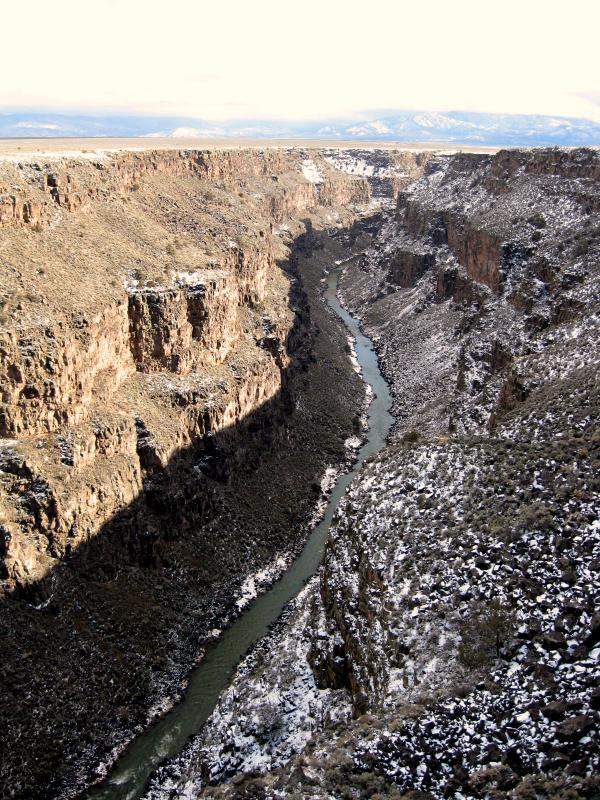New Mexico - March 2010
Carlos and I spent a week in New Mexico with Road Scholar (formerly Elderhostel). The landscape is dramatic and changeable (like the weather, which went from sun to snow and back again, LOL). It was a great trip: very intense, highly educational, splitting the time between Albuquerque, Santa Fe and Taos. A full week gave us only the highlights, but it was much more insightful to have learnt some of the history and culture of this state before visiting the various attractions. We were fortunate to have Allen Girdner as our guide, a local historian who created an exhausting but absolutely fascinating schedule of tours, speakers, and museums.
Although we love history, neither Carlos or I specialize in Civil War battles. We had never learned of the Confederate army of 3600 men who came up from Texas on a campaign to capture
The Confederates captured Albuquerque quite easily, but were stopped at Glorieta. The lecture and video about the battle of Glorieta Pass gave life to looking at that particular steep mountainside where Major Chivington's soldiers rappeled down to attack the Confederacy supply wagons.
Losing their supplies meant they couldn’t go any further, and the survivors retreated hastily. This put an end to their dream of capturing the Western territories and their valuable gold mines.
Think of how different history might have been, had the Confederates won the West! Had they been able to capture the western territories, the map of the U.S. might be very different indeed.
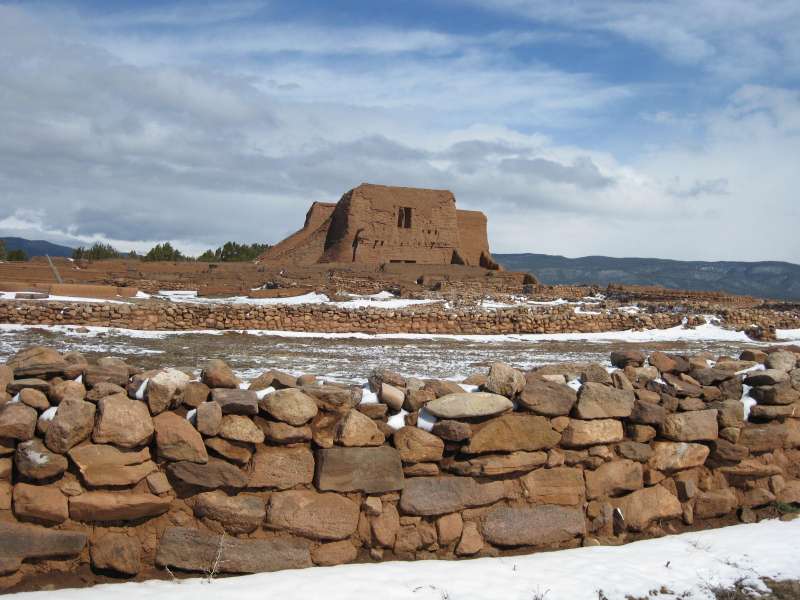
Above: Ruined mission, Pecos National Monument Park, Santa Fe, NM
This is magnificent scenery, all sculpted mountains and stunning plateaus. The famous Hollywood Golden Era actress, Greer Garson, fell in love with the area when she married Buddy Fogelson, a Texas oil millionaire who owned 14,000 acres just south of Santa Fe, which included Glorietta Pass. In 1996 the land was acquired for the Nature Conservancy to forestall a developer. It forms what is now called the Pecos National Monument Park. When driving along the highway, you can still see occasional parts of their original Forked Lightning Ranch – the fence supports are painted pink, with a small turquoise lightning bolt.
Below: Chamisa (Rabbit brush) in the snow, Santa Fe NM
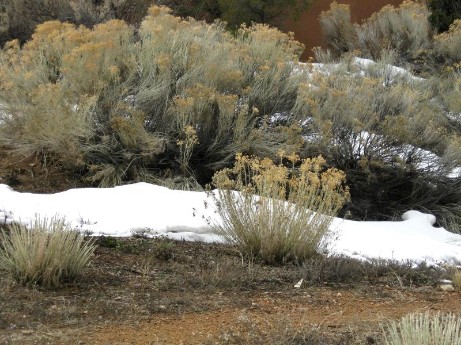
It’s ironic how the 16th century conquistadores tortured the Pueblo Indians in a fruitless attempt to find the fabled “Seven Cities of Gold” in New Mexico. All the time the gold was not there, but instead northwards in Colorado and westward in
The state is currently 40% Indian, 40% Caucasian, and 20% other. Certainly not a lot of Asians or African Americans, of whom we saw…virtually zilch. The Indians prefer to be called Natives, and the Spanish-speakers prefer to be called Hispanics. The Indians have a very strong sense of their history, from having come so close to losing it. Of the original 21 Pueblo tribes, only 17 survive.
The Pueblo Indians were more fortunate than most. The original Spanish land grants used one word – Pueblo - for three different things: the village, the surrounding land, and the Indians.
So for each Pueblo, as the succeeding Mexican and US governments took over, the land grant legality was still accepted. Thus, the Pueblo Indian clans that still survive, still own their own land. This is why they were never moved off to reservations; they retain ownership of considerable acreage throughout NM. Any towns or businesses that are on a tribe’s lands, must pay rent to them to this day.
Below: Statue, Museum of Indian Arts & Culture, Santa Fe NM
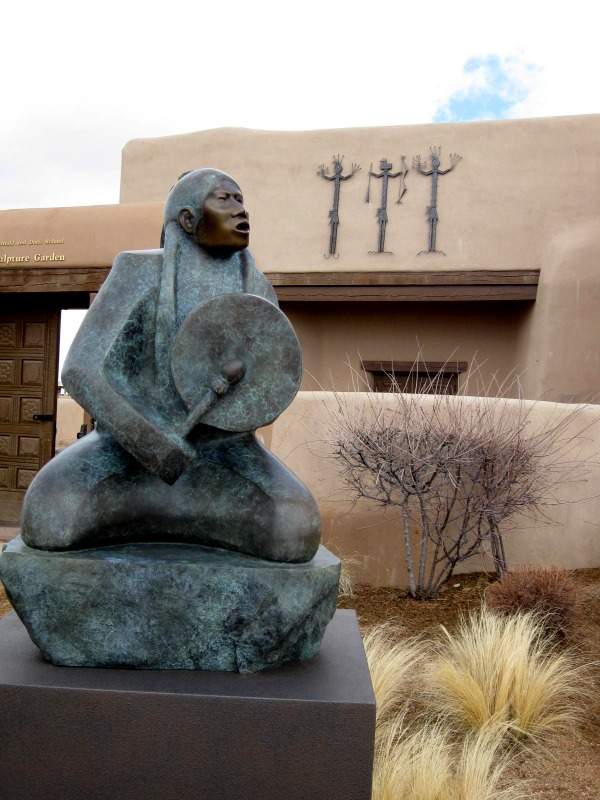
Below: Carlos, Burro Alley mural, Santa Fe, NM
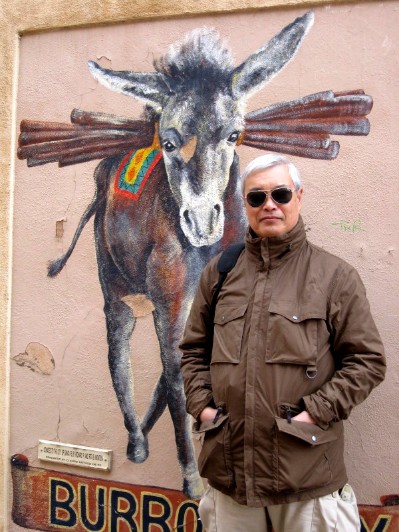
There’s rivalry between Alberquerque (aka ABQ) and Santa Fe. Santa Fe has age and ‘pueblo pastiche’ charm, but ABQ has the money. It’s the business capital of NM, and it’s all Santa Fe’s own fault! When the US opened up the Kansas Territory for settlement, the big railroad boom began in the West. The famous Atchison, Topeka and Santa Fe Railway got as far as Lamy, NM before coming to a halt, defeated by the expense of running rails up and down such harsh terrain. They asked Santa Fe for $88,000 to finish the tracks – but Santa Fe refused.
ABQ, in the meantime, got its own depot from the westward side, and began to grow exponentially. Realizing their mistake, Santa Fe eventually paid for a feeder line from Lamy to their city, but it was too late. ABQ’s track was a more efficient route, and their economic growth jumped over Santa Fe’s, continuing through statehood in 1921 and to this day.
That growth, of course, is a mixed blessing. ABQ has some great Art Deco buildings downtown, but their business area is dominated by the generic high-rises that make it look like every other major city. Santa Fe, left behind in their wake, was able to eventually capitalize on the tourist value of a charming town square with historic buildings.
Right: Whimsy in lieu of charm: the facade above a bar in Albuquerque, NM
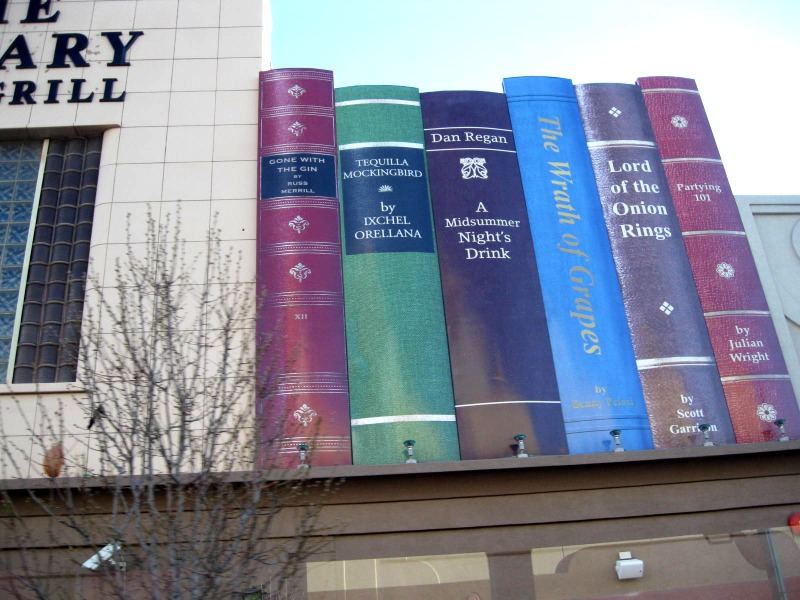
One night Allen organized a mini-concert for us by Ronald Roybal, a mestizo who not only played several songs but discussed his culture and spiritual beliefs; why he calls himself a 'song carrier' instead of a songwriter, for instance. Roybal’s music can be found through his website (http://www.ronaldroybal.com/), and he has a number of videos on YouTube where you can listen to his music.
Music has a different meaning when a culture has no written language. It becomes an expression of emotion and story-telling, but one does not improvise melody or try to ‘jazz it up’. In an oral tradition culture – the Indians strongly resist any attempt to codify/write down their language – playing music is a strictly defined process where technique and instruments are the major differences between one musician’s version and another’s.
It's another fascinating insight into the local culture which we might never have encountered if we'd tried to organize our own visit. Using Road Scholar was the ideal introduction to an unfamiliar area.
Next, the group headed north to Taos on a bus, climbing gradually through spectacular mountains. The weather slowly cleared, giving us amazing views of different geologic rock formations on either side of the road. The snow actually made the landscape more interesting, as only the pinons and some of the brush were green. The cottonwoods, juniper, spruce, sage, and rabbit brush (chamisa) were all dry and dormant.
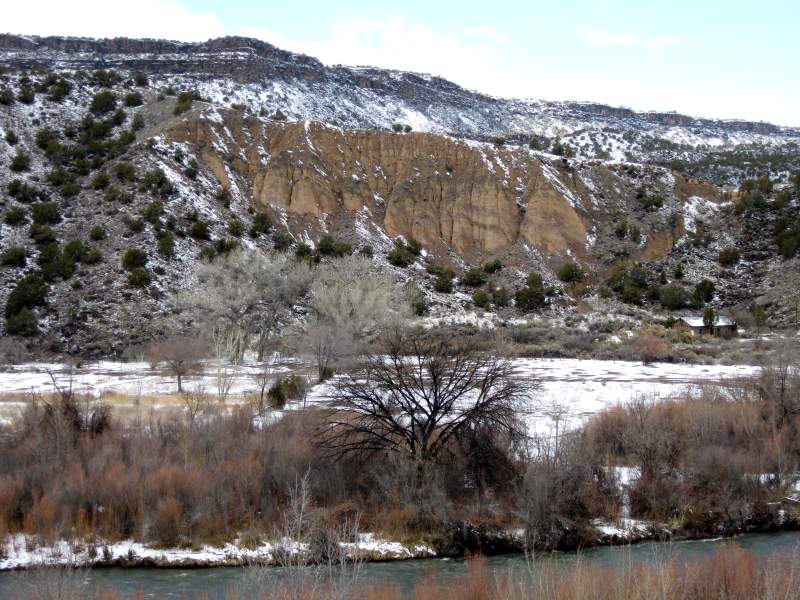
We made a couple of stops along the way, including one at the church Georgia O’Keefe loved to paint. Even the rest stop area was beautiful, with a view of the Rio Grande River and the colorful cliffs.
Left: Rio Grande River and cliffs, outside Taos, NM
This is a beautiful, remote place where outsiders (like those who come to live in Taos) aren’t automatically welcomed except on a superficial basis. The Pueblo Indians up here keep to themselves, shrouding much of their lives from outsiders.
Discussions of the fanatical Catholic 'penitentes' come to life when one is standing on the small plaza of the El Santuario De Chimayo church. It's small and modest, but is called the "Lourdes of America" because of its healing powers. In a few weeks on Good Friday, ten thousand(!) pilgrims will arrive here from as far away as Albuquerque - some on their knees, many carrying crosses.
New Mexico is full of museums. Every city has many, and you can spend a lot of time in them. Even the smallest ones are well organized, and it's interesting to see how each specializes in slightly different areas. Their displays are well organized and so the museums complement one another, each showing a different facet of Southwestern art and culture.
In Taos we visit the Millicent Rogers Museum and even Carlos, who is by no means a lover of art, enjoys it. Ms. Rogers was a collector of Indian jewelry, and had an impressive collection that is on display. Several rooms have the traditional ceilings of large vigas beams with the latigas branches.
It's housed in a hacienda, not the one she lived in but nearby, and the views outside are breathtaking. At an altitude of over 7,000 ft., the light is truly amazing. It's no wonder why this high desert plateau captivates so many people.
Below: An outdoor sculpture, Millicent Rogers Museum, Taos NM

After Taos, we return to ABQ, aka Albuquerque. By this time many of us are getting fatigued - the high altitude can really sap one's endurance. Also, Carlos and I are suffering badly from allergies, probably due to the dust. But Allen saved the best for last: Acoma Pueblo. The Acoma people originally lived on one of the mesas, but moved to their current mesa around 1100 AD. It's the oldest continuing community in the U.S.
The Spanish punished the Acoma severely for their participation in the1599 Revolt. The Indians were forced to build an elaborate church on top of the sacred Indian kiva, after the priests ordered it filled in (kivas are usually partially or completely below ground level). The church, called San Esteban del Rey, is unusual for its height, and we learn there are also secret references to Indian culture that were slipped into the design, unbeknownst to the Spanish.
Most churches we saw are the typical Spanish-style missions – small, dark, lots of hand-painted wooden relics. Acoma’s church is a very lofty space, almost two stories tall. Huge vigas, massive beams, support the ceiling high above. Although there are almost no windows, just leaving the doors open on a sunny day brings in enormous light, since you’re almost 7000 ft above sea level, atop a mesa that is itself 367 feet above the valley floor.
Surprisingly, all the wooden trim, railings, and along the base of the walls upwards for 3’, is painted a cheerful light pink. This with the lofty beamed ceiling and whitewashed walls, makes the interior a more charming space than most missions. But this color has a secret meaning for the Acoma – the paint is derived from the base layer of clay that is part of every mesa. So it represents Earth, as a reminder of their own cultural beliefs.
Above the alter, the ceiling is screened by a painted panel. There are three images on it – a Sun, a Moon, and between them, Clouds. This, too, is a secret reference to the Pueblo story of creation, how they believe life began. (Note: no photographs of the interior of the church are allowed)
To confuse the priests, the Acoma built an above-ground kiva, the sacred meeting place of their people, by disguising it with windows (complete with curtains) as if it were just another room. If you look closely at the photo, right, of the white-painted double ladder, you’ll see a hole in the wall close to the ground, behind the middle log. If one goes to that hole and calls for one of the men using their true Indian name, that man will come out of the meeting. But if you use their American name, there will be no answer!
This double-wide ladder is the tipoff that this is the kiva, and not just an ordinary room.
Below: Mysterious petrograph of a parrot, Albuquerque NM
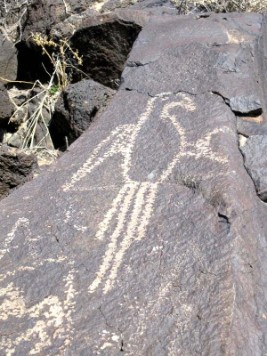
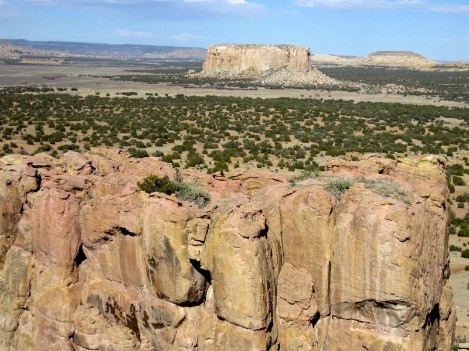
Above: From current Acoma Pueblo mesa, looking across to the original mesa
Below: The double-stepped ladder indicates the secret kiva, disguised as an ordinary room
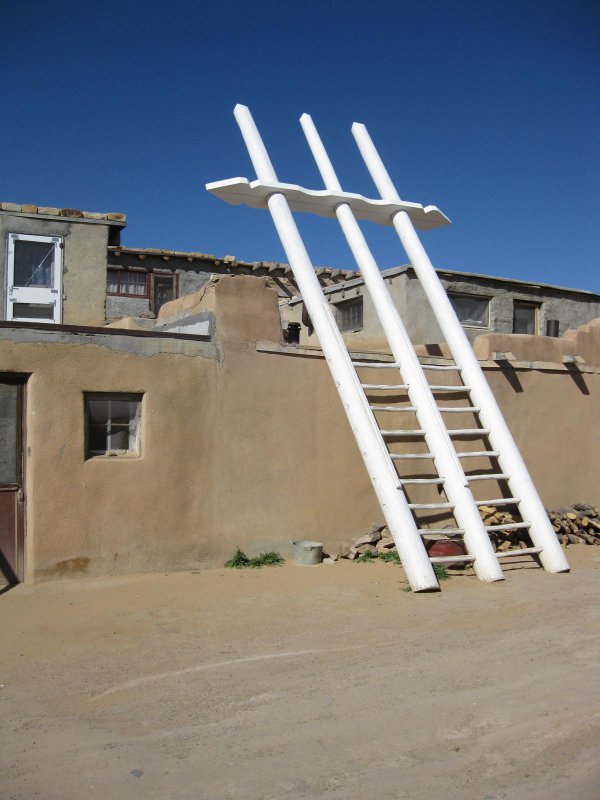
All in all: a great trip, wonderful travel companions who were without exception enthusiastic, energetic, fun people with fascinating life stories, matched by warm New Mexico hospitality and a wide-ranging educational experience. Highly recommended, we both enjoyed this trip even though we have never had any deep interest in Southwestern history. Although we like traveling by ourselves, picking an educational tour like this for an unfamiliar area turned out to be ideal.
More photos:
Below, left: Horse mural, Ledoux St. in Taos NM Below, right: Dried grasses, Santa Fe NM
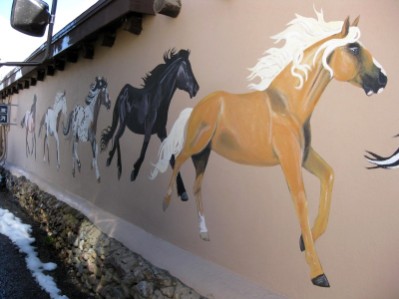
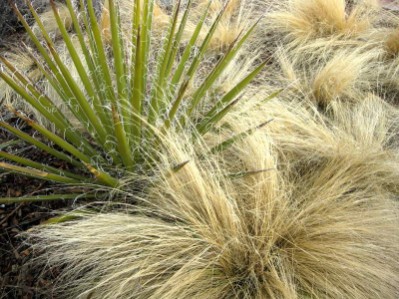
Below: Rio Grande Gorge outside Taos NM
